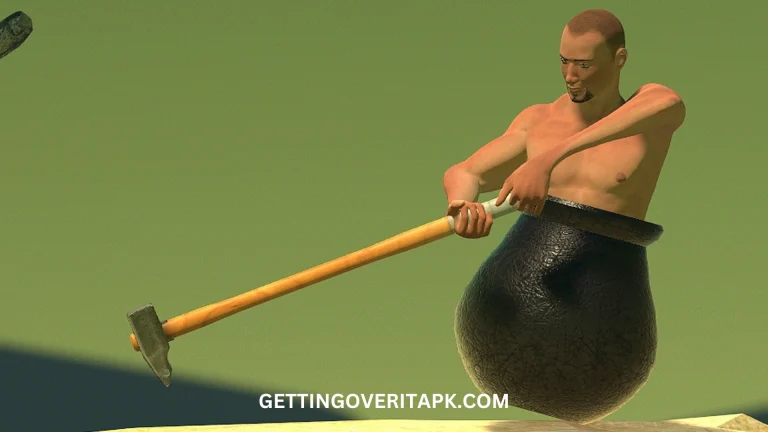After 30 Days of Playing Getting Over It: A Comprehensive Review
Getting Over It with Bennett Foddy is not a game for everyone. It’s brutally hard, often unfair, and will test your patience. But for those who can endure the pain, the reward is immense.
After 30 days, I can confidently say that Getting Over It is a one of a kind experience. It’s a game that pushes you to your limits, not just as a player, but as a person. And while it may bring you to the brink of rage, it also offers moments of pure, unfiltered satisfaction that are hard to come by in today’s gaming world.
If you’re looking for a game that will challenge you in ways you never expected, Getting Over It is worth every minute of frustration. Just be prepared to fall again and again and again.
The Basics
Getting Over It is a simple game. You control a man named Diogenes, who is stuck in a cauldron, and you need to use a hammer to climb a mountain of random, often ridiculous obstacles. There’s one level, no checkpoints, and no progression system.
The challenge lies in the physics-based movement and the sheer precision required to make meaningful progress. One wrong move can send you plummeting back to the bottom, wiping out hours of painstaking effort. And yet, there’s something captivating about it.
Day 1–7: Initial Frustration and the Learning Curve
The first week with Getting Over It is, quite frankly, brutal. The controls feel foreign, clunky, and almost intentionally designed to make you feel like a failure. Each attempt to scale the mountain feels like battling against a force that doesn’t want you to succeed.
At first, I found myself making minimal progress. After an hour of play, I would fall back to the starting point and feel an overwhelming sense of futility. The game’s narrator, Bennett Foddy, doesn’t help matters, either. Every time I fell, his philosophical musings on failure and persistence added salt to the wound. It’s as if the game is mocking you, questioning why you’re even trying.
However, by the end of the first week, something clicked. I began to understand the mechanics better. The hammer’s movements, which once felt awkward, started to make sense. There was a noticeable improvement, though small victories were often overshadowed by significant setbacks.
Day 8–15: Finding the Rhythm
In my second week, I found myself getting further up the mountain more consistently. Muscle memory kicked in, and I started anticipating when and where I would fall. In the notorious “Orange Hell” section, below, I have added a video tutorial guide about orange hell, which had been a nightmare in the first few days, became more manageable. I was still falling, often but I fell with purpose, knowing that each failure was a step toward improvement.
The emotional rollercoaster continued, but now, moments of accomplishment were shining through the frustration. I began to appreciate the game for what it was: not just a test of dexterity, but a challenge to my patience and persistence. The joy of overcoming a difficult section was profound, especially knowing how easy it was to lose it all in an instant.
Day 16–23: The Zen of Failure
By the third week, something surprising happened: I stopped caring about falling. Well, maybe not entirely, but my emotional reactions softened. Getting Over It stopped being just a game and became a meditative exercise. Each fall was still frustrating, but I no longer felt the anger or despair that had dominated my earlier experience.
I realized that the game mirrors life’s challenges in many ways. You work hard, make progress, and sometimes, you fall back to square one. But you pick yourself up and try again. Bennett Foddy’s narration, which had once felt condescending, now felt insightful. His philosophical ramblings about persistence, failure, and the human condition resonated with me as I continued to climb, fall, and repeat.
Day 24–30: The Final Push
By the final week, I had reached the summit several times. My total playtime had reached well over 20 hours, and I could complete the game in under an hour on a good run. But even with mastery, the game continued to surprise me. A single moment of carelessness could still undo an hour’s work. The knowledge that you are never truly safe from failure is what keeps Getting Over It exciting, even after repeated playthroughs.
Interestingly, I found myself enjoying the game more as I improved. The more I played, the more I appreciated its design. It’s a game built to make you better, not by offering rewards or leveling systems, but by forcing you to practice and learn from your mistakes. Each fall teaches you something new, and each climb sharpens your skills. It’s an odd mix of frustration and satisfaction that no other game has managed to replicate for me.
What Makes Getting Over It Special?
So, after 30 days, what makes Getting Over It stand out? Here are the key takeaways:
- A Unique Test of Willpower: This game is more than just a platformer, it’s a test of your mental fortitude. The repeated failures and slow progress can wear you down, but those who persevere will find the satisfaction of success far outweighs the frustration.
- No Handholding: Unlike most modern games, Getting Over It doesn’t offer checkpoints, tutorials, or difficulty options. You’re thrown into the deep end, and it’s up to you to sink or swim. This creates a learning experience that feels earned and personal.
- Brilliantly Simple Mechanics: The game uses one mechanic, swinging a hammer and yet it offers incredible depth. The more you play, the more you realize how nuanced and precise the controls are. Mastery takes time, but it’s achievable.
- Metaphorical Gameplay: While Getting Over It is physically challenging, it’s also deeply philosophical. Bennett Foddy’s narration, while annoying at times, offers a perspective on failure, persistence, and success that feels surprisingly profound by the end.
- Replayability Through Mastery: Even after completing the game, I found myself coming back for more. The challenge of improving my time and mastering every section kept me hooked. It’s the kind of game where speedruns feel like the ultimate expression of skill.
Is Getting Over It the Hardest Game in the World?
While it’s hard to label any game as “the hardest,” Getting Over It with Bennett Foddy certainly makes a strong case. The game’s brutal difficulty comes from its physics-based controls and punishing gameplay. Every slip, every fall, sends you right back to the start, with no checkpoints to save your progress. What makes it so hard is not just the complex movement mechanics, but the emotional toll it takes. Falling after hours of effort can feel devastating, making Getting Over It a mental challenge as much as a physical one.
However, there are games like Dark Souls and Sekiro: Shadows Die Twice that are also known for their difficulty. What sets Getting Over It apart is that its difficulty feels personal. It’s just you, a hammer, and a mountain that seemingly mocks every mistake you make. So, while it may not be the hardest game ever, it’s certainly up there for most players.
Is Getting Over It Hard on Mobile?
Absolutely. Getting Over It is notoriously difficult on any platform, but the mobile version adds another layer of challenge. The controls, which rely on swiping motions to maneuver the hammer, are even more imprecise on a touch screen. Many players find it harder to control their movements on mobile compared to playing with a mouse on PC.
That being said, there are plenty of players who manage to conquer the game on mobile, proving that with enough determination, it can be done. Just be prepared for a more challenging experience than you might expect.



